新防衛計画大綱の閣議決定に関して、以前人民日報の記事について御紹介致しましたが、今回はアメリカの報道について御紹介致します。
応援して頂ける方は、ここをクリック↓人気ブログランキングへ

関連ブログ:新「日本の「新防衛大綱」の針路は?:人民日報
平成23年度以降に係る防衛計画の大綱
THE WALL STREET JOURNALから
Japan Refocuses Its Defense With an Eye Toward China(DECEMBER 16, 2010 WSJ.com)
―――――――――― ここから ――――――――――
TOKYO-Joining other neighbors that are adjusting their policies in response to China's rapid military buildup, Japan on Friday unveiled a new set of national-security guidelines, refocusing its defense toward the oceans and skies in the south and west of the nation.
Tokyo's new National Defense Program Guidelines feature modernizing its self-defense capabilities to reflect the geopolitical changes in recent years, including China's growing naval presence in the northern Pacific and North Korea's aggressive military provocations. The document, which replaces the one adopted in 2004, lays out the basic policies and concepts for the nation's defense strategies and capabilities for the coming decade.
Calling Japan's national-security ties with the U.S. "indispensable," the guidelines call for "deepening and developing" the bilateral alliance with the U.S., and pledges to maintain financial support for U.S. troops based in Japan at current levels despite its dire fiscal conditions. To further boost the stability in the region, security cooperation with other allies of the U.S. - South Korea, Australia, the Association of Southeast Asian Nations, and India - will also be strengthened.
Describing China's military expansion as an "issue of concern for the regional and international communities," Japan now plans to boost its maritime and air surveillance capabilities, and beef up the defense of its islands, including Okinawa and other islands located between Japan's Kyushu and Taiwan. Specifically, the Ground Self-Defense Force, or the army, will build permanent stations on some of these islands, while the air force will add more troops to its existing base in Okinawa.
In a statement posted late Friday on the Chinese Foreign Ministry's website, spokeswoman Jiang Yu dismissed the Japanese position, saying that China is a force for peace and development in Asia and "doesn't constitute a threat to anyone."
"Other countries don't have the right to pose as representatives of the international community and irresponsibly gossip about China's development," she said.
Abandoned in the new guidelines is a Cold War-era defense posture that maintains a stable and large army presence to deter full-scale invasions by enemy forces from the north, namely Russia. In a symbolic shift, the size of the country's submarine fleet will expand to 22 from 16, while the number of tanks will drop to 400 from the current 600.
More
National Defense Program Guidelines
"Our national-security policy hasn't caught up with the reality of the post-Cold War era," Chief Cabinet Secretary Yoshito Sengoku said in an interview this week. "We need to build a rock-solid foundation for a new order for the Asia-Pacific region, by strengthening the U.S.-Japan alliance and coordinating better with South Korea and Australia in our defense policy."
Japan is one of several Asian countries that are seeking to update their defense strategies and stepping closer to the U.S., as China flexes its military muscle. While each country seeks to expand trade with China, and to avoid open confrontation, many are hedging their bets on the military front in case Beijing uses its newfound strength to address territorial issues around its land and sea borders.
Tokyo confronted Beijing in September after arresting a Chinese sea captain whose boat rammed into Japanese coast guard vessels in disputed waters in the East China Sea. But as China jacked up pressure, the captain was released abruptly, setting off bitter criticism of the government within Japan.
The most significant example of nations reacting to China is India, which after decades focusing on archrival Pakistan has deployed advanced fighter jets and extra troops to the Chinese border in the last two years, at the same time as boosting defense ties with the U.S., Japan, South Korea and Vietnam.
Japan's Defense Capabilities
(2010/2004)
Ground Self-Defense Force
* Personnel - 154,000/155,000
* Tanks - 400/600
Maritime Self-Defense Force
* Destroyers - 48/47
* Submarines - 22/16
Air Self-Defense Force
* Combat Aircraft - 340/350
Ballistic missile defense
* Aegis-equipped destroyers - 6/4
* Surface-to-air guided missile units - 6 groups/3 groups
China has been trying to ease regional concern in recent weeks: Premier Wen Jiabao Wednesday went on his first visit to India in five years. China also resumed high-level military talks with the U.S. last week after suspending them in January.China's response to Japan's new guidelines - details of which have been openly discussed by officials in recent days - was relatively restrained. "Our development is peaceful and poses no threat to any other country. China pursues a defensive national security policy," said Foreign Ministry spokeswoman Jiang Yu on Thursday.
An increasingly popular notion among China's military strategists that the U.S. and its allies are trying to "contain" China has raised concerns in Washington. The U.S. has responded by steadily reasserting its influence in Asia this year, after a decade focusing on the wars in Iraq and Afghanistan.
"It has become increasingly evident that China is pursuing a long-term, comprehensive military buildup that could upend the regional security balance," Wallace Gregson, assistant secretary of defense for Asia, told an event organized by the Washington-based Progressive Policy Institute Tuesday.In the new guidelines, Japan had to balance its desire to upgrade its capabilities and the needs to keep its defense spending in check because of the nation's huge government debts. The number of troops in the Ground Self-Defense Force will be reduced by 1,000 to 154,000 over the next five years, while those at the navy and air force will be kept steady. The self-defense forces will also accelerate an overhaul of its human-resources policy, curtailing the seniority system and giving more responsibility to younger, and less costly, personnel.Japan aims to maintain its overall defense-related spending at 23.39 trillion yen ($280 billion) a year or less over the next five years.
―――――――――― ここまで ――――――――――
次に、New York Times
Japan Announces Defense Policy to Counter China(December 16, 2010 NYTimes.com)
―――――――――― ここまで ――――――――――
TOKYO - Japan announced a new defense policy on Friday that will respond to China’s rising military might by building more submarines and other mobile forces capable of defending Japan’s southernmost islands.
The new National Defense Program Guidelines are the biggest step yet in a decade-long shift away from cold war-era deployments of heavy tank and artillery units on the northern island of Hokkaido - to counter a now-vanished Soviet threat - and toward bolstering Japanese forces in the southern islands around Okinawa, where China’s navy has become a growing presence.
The new guidelines also used uncharacteristically strong language to warn of China’s rapidly modernizing military, calling it “a matter of concern for the region and the international community.” China’s growing naval capabilities have been a particular concern in Japan since Beijing and Tokyo clashed diplomatically three months ago over uninhabited islands claimed by both nations but controlled by Japan. The islands are called the Senkaku in Japanese and Diaoyu in Chinese.
In Beijing, the Foreign Ministry criticized the new policy as “irresponsible” and suggested that it was based on a misunderstanding of China’s intentions. “China adheres to the road of peaceful development and pursues a defensive national defense policy,” Jiang Yu, the Foreign Ministry spokeswoman, said in a statement. “We have no intention to be a threat to anyone.”
The new policy called for increasing the number of Japan’s submarines to 22 from the current 16, while reducing the number of tanks by a third to about 400. It also called for creating more mobile forces, which analysts have said could include creating new air and seaborne units that could quickly move to defend remote islands.
The guidelines also called for increasing military cooperation with the United States, Japan’s postwar protector, and other democracies in the region including South Korea, Australia and India. It did not address recent requests from Washington for the Japanese military, known as the Self-Defense Forces, to join in three-way drills with the United States and South Korea that would be aimed at North Korea.
Japan has long resisted American calls to increase its military role in the region because of the constraints of its pacifist postwar Constitution and the bitter memories of devastating defeat in World War II. The new guidelines seemed to indicate a willingness to slightly raise Japan’s military profile, but only in a defensive manner, and in conjunction with the United States.
The guidelines also called for reconsidering Japan’s self-imposed ban on the export of weapons, a step that would make it easier for Japan to join other nations, and particularly the United States, in the joint development of expensive new weapons systems.
Japan has already joined the United States in developing new anti-missile systems. Friday’s guidelines called for deploying more Patriot interceptor missiles to shoot down ballistic missiles from North Korea, which has been developing missiles and nuclear weapons.
The new guidelines were to have been released last year but were delayed by the Democratic Party’s election victory that ended a half-century of virtual one-party rule in Japan.
After initially disagreeing with Washington over an American air base on Okinawa, the left-leaning Democrats under Prime Minister Naoto Kan have moved closer to the United States, pushed by concerns over China’s increasing influence and North Korean provocations like last month’s shelling of a South Korean island.
Andrew Jacobs contributed reporting from Beijing.
An earlier version of this article misspelled the name of the Japanese prime minister. He is Naoto Kan, not Naoto Khan.
―――――――――― ここまで ――――――――――
防衛力の強化を、と思われる方は、
ここをクリック↓

人気ブログランキングへ
応援して頂ける方は、ここをクリック↓人気ブログランキングへ
関連ブログ:新「日本の「新防衛大綱」の針路は?:人民日報
平成23年度以降に係る防衛計画の大綱
THE WALL STREET JOURNALから
Japan Refocuses Its Defense With an Eye Toward China(DECEMBER 16, 2010 WSJ.com)
―――――――――― ここから ――――――――――
TOKYO-Joining other neighbors that are adjusting their policies in response to China's rapid military buildup, Japan on Friday unveiled a new set of national-security guidelines, refocusing its defense toward the oceans and skies in the south and west of the nation.
Tokyo's new National Defense Program Guidelines feature modernizing its self-defense capabilities to reflect the geopolitical changes in recent years, including China's growing naval presence in the northern Pacific and North Korea's aggressive military provocations. The document, which replaces the one adopted in 2004, lays out the basic policies and concepts for the nation's defense strategies and capabilities for the coming decade.
Calling Japan's national-security ties with the U.S. "indispensable," the guidelines call for "deepening and developing" the bilateral alliance with the U.S., and pledges to maintain financial support for U.S. troops based in Japan at current levels despite its dire fiscal conditions. To further boost the stability in the region, security cooperation with other allies of the U.S. - South Korea, Australia, the Association of Southeast Asian Nations, and India - will also be strengthened.
Describing China's military expansion as an "issue of concern for the regional and international communities," Japan now plans to boost its maritime and air surveillance capabilities, and beef up the defense of its islands, including Okinawa and other islands located between Japan's Kyushu and Taiwan. Specifically, the Ground Self-Defense Force, or the army, will build permanent stations on some of these islands, while the air force will add more troops to its existing base in Okinawa.
In a statement posted late Friday on the Chinese Foreign Ministry's website, spokeswoman Jiang Yu dismissed the Japanese position, saying that China is a force for peace and development in Asia and "doesn't constitute a threat to anyone."
"Other countries don't have the right to pose as representatives of the international community and irresponsibly gossip about China's development," she said.
Abandoned in the new guidelines is a Cold War-era defense posture that maintains a stable and large army presence to deter full-scale invasions by enemy forces from the north, namely Russia. In a symbolic shift, the size of the country's submarine fleet will expand to 22 from 16, while the number of tanks will drop to 400 from the current 600.
More
National Defense Program Guidelines
"Our national-security policy hasn't caught up with the reality of the post-Cold War era," Chief Cabinet Secretary Yoshito Sengoku said in an interview this week. "We need to build a rock-solid foundation for a new order for the Asia-Pacific region, by strengthening the U.S.-Japan alliance and coordinating better with South Korea and Australia in our defense policy."
Japan is one of several Asian countries that are seeking to update their defense strategies and stepping closer to the U.S., as China flexes its military muscle. While each country seeks to expand trade with China, and to avoid open confrontation, many are hedging their bets on the military front in case Beijing uses its newfound strength to address territorial issues around its land and sea borders.
Tokyo confronted Beijing in September after arresting a Chinese sea captain whose boat rammed into Japanese coast guard vessels in disputed waters in the East China Sea. But as China jacked up pressure, the captain was released abruptly, setting off bitter criticism of the government within Japan.
The most significant example of nations reacting to China is India, which after decades focusing on archrival Pakistan has deployed advanced fighter jets and extra troops to the Chinese border in the last two years, at the same time as boosting defense ties with the U.S., Japan, South Korea and Vietnam.
Japan's Defense Capabilities
(2010/2004)
Ground Self-Defense Force
* Personnel - 154,000/155,000
* Tanks - 400/600
Maritime Self-Defense Force
* Destroyers - 48/47
* Submarines - 22/16
Air Self-Defense Force
* Combat Aircraft - 340/350
Ballistic missile defense
* Aegis-equipped destroyers - 6/4
* Surface-to-air guided missile units - 6 groups/3 groups
China has been trying to ease regional concern in recent weeks: Premier Wen Jiabao Wednesday went on his first visit to India in five years. China also resumed high-level military talks with the U.S. last week after suspending them in January.China's response to Japan's new guidelines - details of which have been openly discussed by officials in recent days - was relatively restrained. "Our development is peaceful and poses no threat to any other country. China pursues a defensive national security policy," said Foreign Ministry spokeswoman Jiang Yu on Thursday.
An increasingly popular notion among China's military strategists that the U.S. and its allies are trying to "contain" China has raised concerns in Washington. The U.S. has responded by steadily reasserting its influence in Asia this year, after a decade focusing on the wars in Iraq and Afghanistan.
"It has become increasingly evident that China is pursuing a long-term, comprehensive military buildup that could upend the regional security balance," Wallace Gregson, assistant secretary of defense for Asia, told an event organized by the Washington-based Progressive Policy Institute Tuesday.In the new guidelines, Japan had to balance its desire to upgrade its capabilities and the needs to keep its defense spending in check because of the nation's huge government debts. The number of troops in the Ground Self-Defense Force will be reduced by 1,000 to 154,000 over the next five years, while those at the navy and air force will be kept steady. The self-defense forces will also accelerate an overhaul of its human-resources policy, curtailing the seniority system and giving more responsibility to younger, and less costly, personnel.Japan aims to maintain its overall defense-related spending at 23.39 trillion yen ($280 billion) a year or less over the next five years.
―――――――――― ここまで ――――――――――
次に、New York Times
Japan Announces Defense Policy to Counter China(December 16, 2010 NYTimes.com)
―――――――――― ここまで ――――――――――
TOKYO - Japan announced a new defense policy on Friday that will respond to China’s rising military might by building more submarines and other mobile forces capable of defending Japan’s southernmost islands.
The new National Defense Program Guidelines are the biggest step yet in a decade-long shift away from cold war-era deployments of heavy tank and artillery units on the northern island of Hokkaido - to counter a now-vanished Soviet threat - and toward bolstering Japanese forces in the southern islands around Okinawa, where China’s navy has become a growing presence.
The new guidelines also used uncharacteristically strong language to warn of China’s rapidly modernizing military, calling it “a matter of concern for the region and the international community.” China’s growing naval capabilities have been a particular concern in Japan since Beijing and Tokyo clashed diplomatically three months ago over uninhabited islands claimed by both nations but controlled by Japan. The islands are called the Senkaku in Japanese and Diaoyu in Chinese.
In Beijing, the Foreign Ministry criticized the new policy as “irresponsible” and suggested that it was based on a misunderstanding of China’s intentions. “China adheres to the road of peaceful development and pursues a defensive national defense policy,” Jiang Yu, the Foreign Ministry spokeswoman, said in a statement. “We have no intention to be a threat to anyone.”
The new policy called for increasing the number of Japan’s submarines to 22 from the current 16, while reducing the number of tanks by a third to about 400. It also called for creating more mobile forces, which analysts have said could include creating new air and seaborne units that could quickly move to defend remote islands.
The guidelines also called for increasing military cooperation with the United States, Japan’s postwar protector, and other democracies in the region including South Korea, Australia and India. It did not address recent requests from Washington for the Japanese military, known as the Self-Defense Forces, to join in three-way drills with the United States and South Korea that would be aimed at North Korea.
Japan has long resisted American calls to increase its military role in the region because of the constraints of its pacifist postwar Constitution and the bitter memories of devastating defeat in World War II. The new guidelines seemed to indicate a willingness to slightly raise Japan’s military profile, but only in a defensive manner, and in conjunction with the United States.
The guidelines also called for reconsidering Japan’s self-imposed ban on the export of weapons, a step that would make it easier for Japan to join other nations, and particularly the United States, in the joint development of expensive new weapons systems.
Japan has already joined the United States in developing new anti-missile systems. Friday’s guidelines called for deploying more Patriot interceptor missiles to shoot down ballistic missiles from North Korea, which has been developing missiles and nuclear weapons.
The new guidelines were to have been released last year but were delayed by the Democratic Party’s election victory that ended a half-century of virtual one-party rule in Japan.
After initially disagreeing with Washington over an American air base on Okinawa, the left-leaning Democrats under Prime Minister Naoto Kan have moved closer to the United States, pushed by concerns over China’s increasing influence and North Korean provocations like last month’s shelling of a South Korean island.
Andrew Jacobs contributed reporting from Beijing.
An earlier version of this article misspelled the name of the Japanese prime minister. He is Naoto Kan, not Naoto Khan.
―――――――――― ここまで ――――――――――
防衛力の強化を、と思われる方は、
ここをクリック↓
人気ブログランキングへ










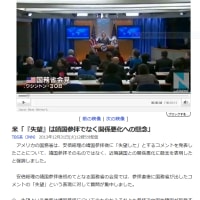
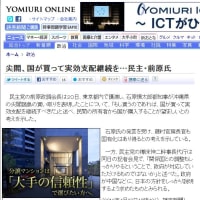
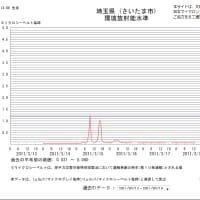
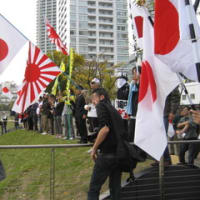
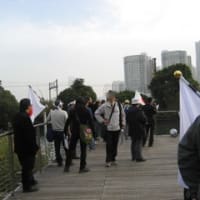

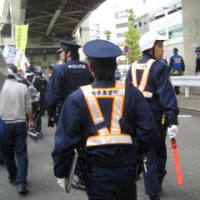


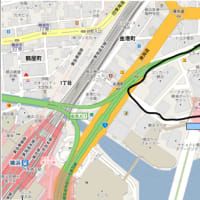
※コメント投稿者のブログIDはブログ作成者のみに通知されます